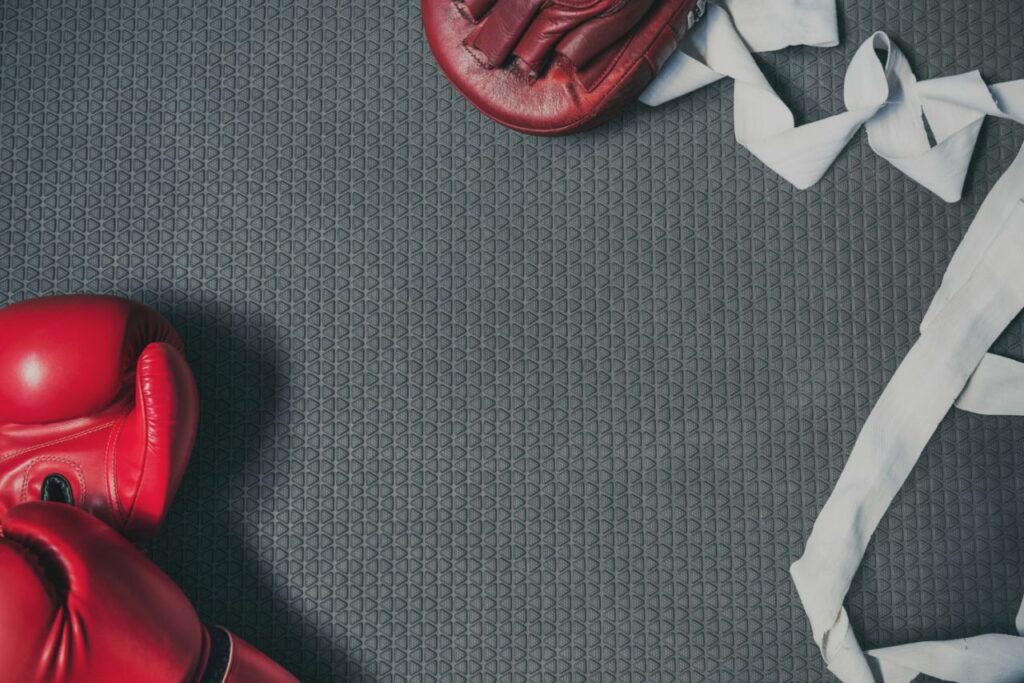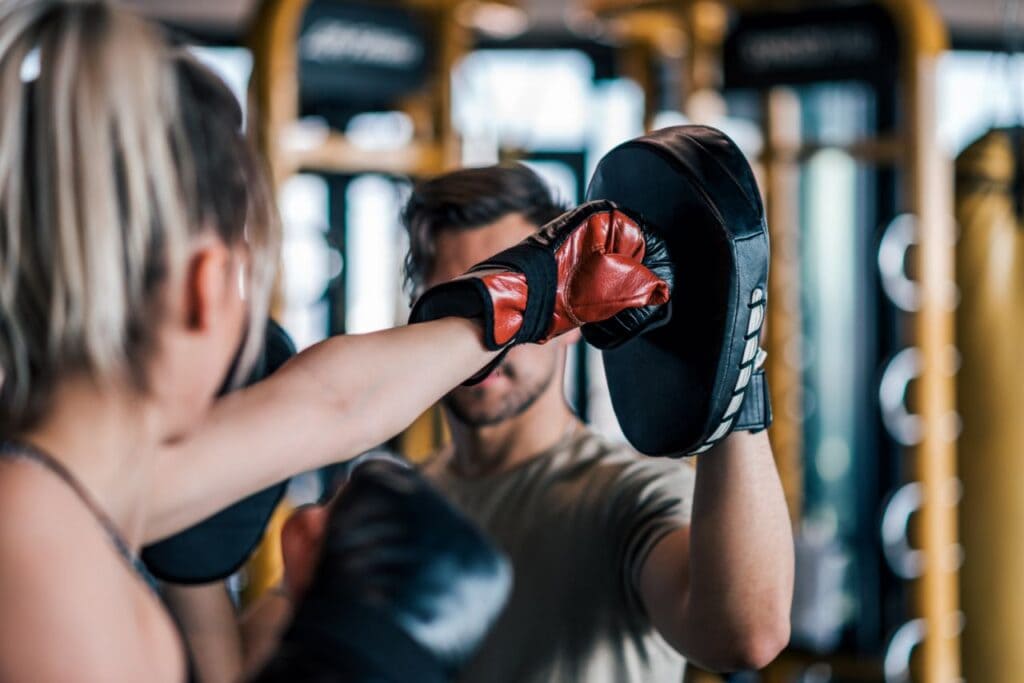One of the very first boxing techniques that any budding fighter should focus on mastering is a standard boxing stance. It seems so basic of skill to master, so simple, but it is something that many still can’t quite get right.
The way you stand in the ring is the foundation of everything. It will determine your power, how you move, and how well you remain balanced throughout a fight. Conversely, the wrong stance can take you out in seconds.
Why are stance and balance so important in boxing? Learning how to stand in the ring and proper foot positioning is one of the first things you study when you take up the ‘sweet science.’
Beginners have to re-learn using their feet and move to become good boxers in many ways. If you lose your balance in boxing, you could find yourself hitting the canvas from the mere force of a punch. In the same vein, punches you take are more damaging.
Mastering your balance and perfecting your stance means you can also launch attacks with the proper kinetic transfer. This makes your punches more powerful. It also means you can maneuver and evade an opponent’s punches with greater efficiency and even allow you to take damage better.
The conventional boxing stance has changed throughout history from era to era. The typical boxing stance has adopted an approach that combines offence with defence in modern boxing. Different boxers adopt different stances depending on their style and ability, but they’re not always the most fundamentally sound.
Relieving pressure from an aggressive opponent, landing your hits and chasing down a jumpy opponent can all be achieved with a proper stance and footwork. However, it can be a difficult element for beginners to understand, and it’s crucial to understand that your footwork and stance aren’t only important in boxing but all martial arts and fighting sports.
Ways To Improve Your Boxing Stance And Boxing Stance
Perfecting your stance is the first and one of the most important factors to consider when starting. Why? Because it can improve and affect your speed and mobility and determine how effective your boxing workout is. The correct form will ensure you are engaging all the correct muscles and give you that full-body workout.
Of course, there is no perfect way to stand in the ring.
Many fighters have adopted variations once they have grown comfortable with a particular style. Still, before you can think about switching things up, there is a standard, strong stance that everyone should learn at the beginning of their training to build that sturdy foundation.
Your ‘perfect’ boxing stance is likely to differ from others as everyone tends to vary stances slightly, with some people preferring a slightly wider or narrower stance. It is therefore important to find your ideal position.
There is no one particular stance to go by. However, you should train yourself in a stance that maximises your potential and plays to your strengths. Of course, the perfect stance is best suited for your particular fighting style and skills. However, there are still some basic guidelines that you should aim to follow to ensure you are maximising your strengths.
Shadowboxing
You may be asking: why shadowboxing and not sparring? Sparring is all well and good, but it is easy to become more attentive to landing blows or avoid strikes to win.
Placing attention on boxing techniques alone can sometimes get lost. With shadowboxing, there is no one coming after you. Your full focus can be placed only on yourself and your skills, which is all you need if you want to devote time to your stance.
Step Work
Using small steps to defend against your opponent is a lot harder than circling the ring and letting your opponent chase you. Taking one, two, then three quick steps forwards and backwards and medium stride can help advance and retreat efficiently when needed.
By practising this footwork and stance formation, you can control your reach and distance in the ring to counter back quickly.
Try this out with a large enough mirror present. Using a mirror with shadowboxing gives you a clearer picture of what you are doing right and what areas need improvement. Do so with gloves so your body gets better used to how it will feel in the ring.
Get into the habit of staying on the balls of your feet.
Falling into a “flat-footed” stance is never an ideal situation in boxing. However, it is a way of standing that increases the chances of being knocked off-guard with little effort.

By lifting off of your heels, you are given a greater amount of mobility and power. Doing this will also improve your piloting skills. You are in a better position of pivoting away from incoming strikes or swiftly taking advantage of an opponent’s opening to land a good hit.
Plyometric Exercises
Plyometric exercises are designed to increase your explosive power. These exercises cover drills that exert your maximum force in short intervals. Some common exercises are ladder drills, box jumps, lateral jumps and single-leg hops.
It would help if you also worked on improving your leg endurance, which can be done through running and cardio exercises. This will ensure that your legs can keep up and support your improved footwork through the entire match.
Proper Foot Placement
To improve your balance for boxing, you first need to understand proper foot placement. You can’t just stand in front of your opponent squared up. That’s a recipe for disaster. So having proper foot placement in your boxing stance is key to having excellent balance.
Where you place your feet, set up the advantages and disadvantages you will have on both offence and defence, especially mobility. The first concept any aspiring boxer should try to understand regarding the boxing stance is toe-heel alignment.
First, start by placing your feet at a shoulder-width distance from each other. Next, take one foot and move it backward. If you’re right-handed (orthodox), your left foot should be in front, toes pointing toward your opponent.
Your right foot should serve as the rear foot. Don’t stand flat on it. Instead, stand on the ball of your rear foot to keep you light and mobile. If you’re left-hand dominant (southpaw), then your right foot should take the lead.
Jump Rope Tricks
Surprisingly these aren’t just important for training montages in movies; jump rope tricks can work at improving your leg endurance, timing and hand-eye-foot coordination all at once. But, of course, the more difficult the trick, the more you’ll be pumping up the intensity.
Turn yourself into a smaller, hard-to-hit target
It is a given that you want to avoid letting your opponent rush in close enough to land that dreaded hard hit. The proper stance comes into play here, of course. You can create a smaller target area, making things much harder for your opponent and benefiting in other ways.
Do not stand before an opponent with your shoulders or chest too squared off.
This will give you a “box-like” appearance and a much larger striking area for your opponent. It will also negatively impact your entire stance as it turns you inward-facing your opponent full-on.
Your hips, legs, and feet can be thrown off if you don’t make a smaller target area. With a turn to the side, that target area shrinks dramatically. You are also hindering your opponent’s reach capabilities by doing this boxing technique.
Lower Body Positioning
Next is knowing how to position your lower body. Here are some general boxing stance principles. The heel of your rear foot should be slightly off floor level, maybe up to an inch off the ground.
The weight on your rear foot should be primarily on the ball. The lead foot heel can be planted, which will help you maximise kinetic energy transfer, thus making your punches more powerful.
Although you need to have the flexibility to shift your weight forward or backward, toward the lead foot or the rear foot, try to maintain a centre of gravity by placing more of your weight toward the lead foot, at about a 55/45 per cent ratio.
Please don’t put too much weight on your front foot because it will make it harder for you to step away fast enough on defence. It also shaves a little off of your straight cross.
Your knees should also be slightly bent. You don’t want the leg extended, which will have you fight too tall. This will give you better balance, increased punching power, and fluid mobility.
Try to keep your feet away from each other.
This may seem like the oddest of tips at first glance, but we assure you that it will be worthwhile. Walking into the ring and walking in your everyday life are completely different things. It is all-too-easy to fall into the trap of squaring off your feet, similar to how you may square off your shoulders or chest. However, this can also lead to you narrowing that gap between your feet.
All of this leads to the perfect opportunity for your opponent to land some devastating blows.
Always remember not to walk as you normally would. Keep your feet turned at that angle and never cross them. Instead, focus on moving your feet by dragging and stepping in and out quickly. This will keep up your momentum and ensure that your stance remains firm.
Upper Body Positioning
Keep your shoulders and arms loose and relaxed. Elbows should be tucked in to protect the body. Your lead hand should flow in front of your body, ready to block and parry incoming shots.
The rear glove should cover your chin up to the cheekbone without impairing your vision. It is responsible for protecting you against your opponent’s left jabs, as well as left hooks.
Your chin should be tucked into your chest. Most pro boxers bite down on their mouthpiece and clench their jaw tight. This minimises damage on impact, should you take a solid punch to the chin.
Mexican-American legend Oscar De La Hoya was notorious for biting down so hard on his mouthpiece that his teeth would break through the silicone rubber.
As with everything in your boxing stance, you should be flowing, loose, and relaxed, ready to explode with your techniques rather than tight and tense. Being too tight and tense burns up energy quickly and allows for the rapid buildup of lactic acid in your muscles, which will wear out your arms and legs fast.
Properly centre and distribute weight throughout your body.
If you feel your stance is lacking anywhere, check to make sure that you are not leaning forward or backward too much. It is best to keep the weight between your front and back legs evenly distributed.
Allowing yourself to move too far back or forward runs the chance of dampening your power and movement. It also throws your entire stance out of whack.
However, there are times when you may want to add a hint of more weight to the lead leg in the event of wanting to deliver a powerful blow to your opponent quickly. This should only be done with the utmost caution, though, as too much of it can make you susceptible to a prompt counterattack.
Practice makes perfect
Putting this into practice is the best way to improve. Finding your boxing stance that you are comfortable with can take a while and be quite daunting, especially if you are starting.
We know that it can be frustrating when you are not getting the hang of such a standard stance. However, you cannot accomplish anything if you fail to practice it. Nothing happens overnight.
Benefits Of A Strong Boxing Stance
From the first moment you find the right boxing stance, you’ll feel the difference and improvement in your ability. With the proper boxing stance, boxing can bring you more power, stability, speed, and balance.
You’ll find your punches gaining more reach without forcing you to overextend your body or put your feet into a vulnerable position.
If you need to react quickly to dodge or counterattack, the proper stance will give you more stability to quickly pivot away or extend onto your toes for a one-two combo.
The important takeaway to note is that there isn’t one stance to achieve this. Your height and mobility can affect which stance will work for you best. The aim is to find the perfect stance that gets you using your body most efficiently.
Boxing Stance Common Mistakes
- Stand With Your Feet Too Wide Apart: You can easily be knocked off balance.
- Stand With Your Feet Too Square: Not only can you get knocked off balance easily, but you’re also offering up a bigger target to your opponent.
- Feet in a Straight Line: Don’t stand in a straight line as if you’re standing on a tightrope. Your feet should maintain a good distance apart (a few inches outside your shoulder width).
- Pointing Both Feet Forward: The toes of both your feet should be positioned at an angle (see above) and not pointed straight forward towards your opponent.
- Lean Too Far Forward or Backwards: Putting too much weight on your front or back foot hinders your offensive/defensive movement and power.
- Standing up Too Straight: Your legs and spine shouldn’t be completely straight. They should always be bent forward very slightly.
- Standing Too Sideways: You may think that standing completely to the side offers less of a target to your opponent, but while this is true, you’re completely taking your rear hand out of the picture.
- Lead Hand Too Low: You’ll see that nearly all fighters drop their lead head from time to time for different reasons. It’s OK to do it as long as it’s intended as a feint or a decoy, but not if it’s out of bad habits.
- Dropping Rear Guard: No matter what, keep your rear hand up and if you throw a punch with your rear hand, make sure you bring it back into position. The last thing you want is to get caught by a counter lead hook that you didn’t see coming.
Conclusion
Without having a solid boxing stance, you are setting yourself up for future, unnecessary difficulties. The power, mobility, and speed behind each attack start-up in your core and lower body. It is why having a good stance is so necessary.
So, we hope that if you are still struggling with all of this, you can use some of the above tips to improve the way you stand.
FAQs
What Are The 2 Boxing Stances?
The two most common boxing stances are Orthodox and South Paw. For a brief overview of these stances, check out this video (link to video). But there are other, less common boxing stances as well. Keep in mind everyone can have their combination of stance and guard as long as they use proper form.
What Is The Correct Boxing Stance?
Your feet are spread about shoulder-width or a few inches wider. Your knees will always be bent. This gives your more power, more balance, and more mobility. Your hips will always be relaxed and heavy, which gives you even more balance and more power.
Which Boxing Stance Is Better Orthodox Or Southpaw?
Generally, it is agreed that the Southpaw style is more ‘open’ than the Orthodox, making the southpaw more comfortably positioned. The closed Orthodox stance means their defence is lacking, while the southpaw’s opposite positioning means greater control.
What Is Unorthodox Stance Boxing?
An Unorthodox Boxing Stance is any stance that doesn’t routinely follow the conventions of an Orthodox Stance. Southpaw is the most common and polarised example of this, so much so that it may be regarded as a convention of its own.
Can You Be Both Southpaw And Orthodox In Boxing?
Switching between orthodox and southpaw and vice versa is known to throw a lot of opponents off track. This means your opponents have to deal with both stances at different times in a single bout. In addition, it could get very confusing having to defend against multiple attacks from varied angles.
- Find a gym. Boxing gyms aren't typically found in the yellow pages, but there are resources on the internet that can lead you in the right direction. ...
- Be sure the gym is within striking distance. ...
- Be open-minded. ...
- Choose your coach carefully. ...
- Do judge the gym by its cover.
So, can boxing be self-taught? Boxing can be self-taught but it's not the quickest and most effective way to become better at the sport because you aren't able to tap into the knowledge of a boxing coach who would be able to help you one to one.
Best Age to Start
Specialists in sports medicine believe that boxing classes are better to start from 9-10 years. Starting too early could result in putting the student off, as boxing is hard work and not always as fun as team sports, such as football or rugby.

